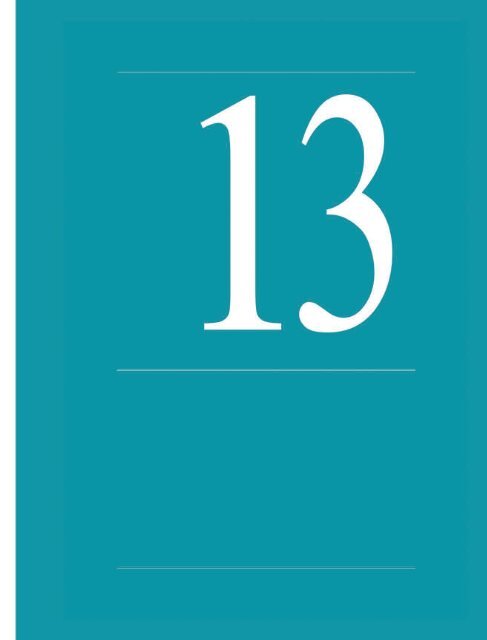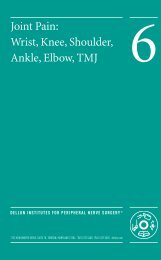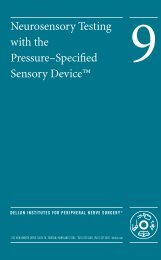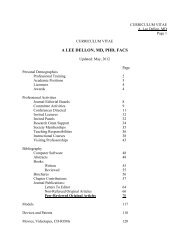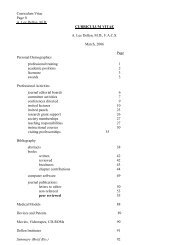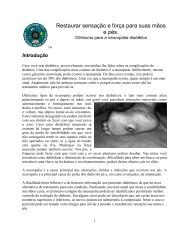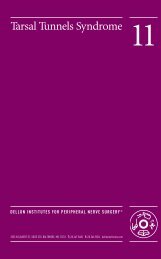Chapter 13 - Dellon Institutes for Peripheral Nerve Surgery
Chapter 13 - Dellon Institutes for Peripheral Nerve Surgery
Chapter 13 - Dellon Institutes for Peripheral Nerve Surgery
You also want an ePaper? Increase the reach of your titles
YUMPU automatically turns print PDFs into web optimized ePapers that Google loves.
<strong>Chapter</strong> ThirteenMIGRAINE & PERIPHERALNERVES
MIGRAINE HEADACHE!!!!!!.
MIGRAINE & PHERIPERAL NERVESINTRODUCTIONMIGRAINE HEADACHE!!!!!!You know what it is. That is not why you are reading this.You have tried diets, given up chocolate and caffeine.You know what you are allergic to and to what you are not allergic.You have tried over-the-counter medicine and prescription medicines.You live in a dark world… Bright light is the enemy!You live in a quiet world…. Loud sound is the enemy!You spend many days each month, sometimes each week….in bed.You have lived, if this is living, like this <strong>for</strong> years, even decades.YOU HEARD THAT A NERVE MAY BE THE CAUSE,AND THAT NERVE SURGERY MAY BE THE ANSWER.THAT IS WHY YOU ARE READING THIS!AND IT IS TRUE.THERE IS HOPE FOR YOUR MIGRAINESWITH PERIPHERAL NERVE SURGERY.<strong>Chapter</strong> <strong>13</strong> 386
A. Lee <strong>Dellon</strong>, MD PhDDEFINITIONSFigure <strong>13</strong>-1A. The Scream. Edvard Munch, 1893.http://ourjourneytosmile.com/blog/wp-content/uploads/2009/06/the-scream-edvard-munch.jpgThe word “migraine” is Greek <strong>for</strong> hemikranium”, or half the head, because that is themost common <strong>for</strong>m of this headache. Migraine headaches have been known and described <strong>for</strong>generations. Their existence is well accepted, but their cause remains a subject of intenseinterest. This interest is intense because, despite the commonly accepted causes which can behelped by diet, medication, and lifestyle changes, there are still millions of people who literallyare disabled by their migraine headaches. They have them more than 15 days a month, andhave been suffering <strong>for</strong> more than 3 months to this degree. So <strong>for</strong> the purposes of this chapter,the distinction between a migraine headache, tension headache, cluster headache, and anyother type of headache will be a simple one. If you are reading this chapter, I assume you havealready consulted your family doctor, your gynecologist, your neurologist, and most likely aheadache specialist, and you have exhausted all the traditional remedies. Yet you still havevery frequent headaches, that usually come on with some sort of pattern, initiated orworsened by light or sound, and which may be accompanied by vomiting. Your headachemost likely is in the back of your head on one side, but may occur on both sides (bilateral),and may progress to involve the front of your head, usually your <strong>for</strong>ehead. Most likely you arefemale, although men have migraines too.MEDICAL TREATMENT & EVALUATIONIt is beyond the scope of this chapter, in a book devoted to the surgical treatment ofpainful peripheral nerve conditions, to discuss the medical workup you must have be<strong>for</strong>e youcome to see a surgeon <strong>for</strong> evaluation of the presence of compression of one or more of theMigraine & <strong>Peripheral</strong> <strong>Nerve</strong>s 387
Pain Solutionsnerves to your scalp. At the very least, you should A) read the basic concepts of Migraine fromWikipedia, available at http://en.wikipedia.org/wiki/Migraine, which is a good basic coverageof the subject, B) have had evaluation to be sure you do not have a brain tumor or vascularmal<strong>for</strong>mation (have a CT scan or MRI of your brain), and C) have failed to have yourheadaches significantly improved by change of diet, avoiding known “triggers” of yourmigraines, and use of specific “migraine” medication <strong>for</strong> at least 6 months.BOTOX BOTOXBOTOXMany doctors will offer you a trial of Botox injection to see if your migraines can behelped. If you have not had this injection, you should. Botox and migraines will be discussedin more detail later in this chapter.RELIEF OF YOUR MIGRAINE PATTERN FOR A PERIOD OFTIME AFTER A BOTOX INJECTION, OR A LOCALANESTHETIC BLOCK, IS THE BEST PREDICTOR OFSUCCESS FOR SURGICAL DECOMPRESSION.Figure <strong>13</strong>-1BThe headache by George Cruikshank, 1835<strong>Chapter</strong> <strong>13</strong> 388
A. Lee <strong>Dellon</strong>, MD PhDCRANIAL NERVE ANATOMY & FRONTAL MIGRAINEIt is time <strong>for</strong> some very sophisticated definitions of the Nervous System. Do not let thismake you “nervous”. It is necessary in order <strong>for</strong> you to avoid the confusion inherent incommon usage of specific words in this chapter.The Nervous System contains the Central Nervous System, which is the brain and spinalcord, and the nerves that are outside the Central Nervous System, the <strong>Peripheral</strong> NervousSystem (see Figure <strong>13</strong>-2). The nerves in the arms and legs, the nerves on the chest and backand belly are peripheral nerves, even though they begin as nerves from the spinal cord. Oncethose nerves leave the vertebra, though spaces called vertebral <strong>for</strong>amen, they become coveredwith a layer of cells, Schwann cells, and are called peripheral nerves. <strong>Peripheral</strong> nerves, incomparison to the nerves in the Central Nervous system, can regenerate, grow, if cut andreconnected. Also, if a peripheral nerve has pressure applied to it, this nerve can send amessage back into the Central Nervous System, reporting injury, and usually interpreted bythe brain as a <strong>for</strong>m of pain.Figure <strong>13</strong>-2. Nervous System from flickr.comThe Central Nervous System is the brain and the spinal cord.All the other nerves that come out from the skull and out fromthe spinal cord are the <strong>Peripheral</strong> Nervous System. Note the skulland vertebral bones are absent.Schwann cells make a complex protein called myelin that coats individual nerve fibersgiving them the ability to conduct impulses more quickly. When the peripheral nerve iscompressed, this myelin begins to degenerate. Chronic nerve compression relates toMigraine & <strong>Peripheral</strong> <strong>Nerve</strong>s 389
Pain Solutionssymptoms that can lead to migraine headaches. My theory * is that the pain message from thecompressed peripheral nerves travels back towards the brain, and stimulates or simulates amessage from the nerves that innervate the inside lining of the skull, the meninges, which arealso branches of the compressed nerves.Your conscious perception is one of headache, not nerve compression.Decompression of a nerve related to migraine headaches permitsthe nerve to regenerate, heal itself, stop sending a pain message,and the migraines can then stop.Figure <strong>13</strong>-3. Cranial <strong>Nerve</strong>s.View of the brain from its underneath surface. Each cranial nerve is colored to distinguish it. The functionsof these nerves is explained in Table <strong>13</strong>-1.http://scientopia.org/blogs/scicurious/2011/05/30/science-101-cranial-nerves-iv-and-vi-the-trochlear-nerveand-abducens-nerve/*<strong>Dellon</strong>, AL, A <strong>Peripheral</strong> <strong>Nerve</strong> Approach to Migraine Headache <strong>Surgery</strong>; commentary on OccipitalArtery Vasculitis Not Identified as a Mechanism of Occipital Neuralgia, by Ducic, I, Felder, JM III,Janis, JE, Plast Reconstr Surg, Manuscript Number: Plast Reconstr Surg, 128:915-917, 2011.<strong>Chapter</strong> <strong>13</strong> 390
A. Lee <strong>Dellon</strong>, MD PhD<strong>Nerve</strong>s that come from the brain, instead of the spinal cord, are called cranial nerves (seeFigure <strong>13</strong>-3). The first two of these, the ones <strong>for</strong> the sense of smell, the olfactory nerves, andthe ones <strong>for</strong> vision, the optic nerves, are direct extensions of the brain, and are really part ofthe brain. There<strong>for</strong>e, like the spinal cord, they cannot regenerate. However all the othercranial nerves begin from masses of cells called ganglia that are in a collection called a nucleus.They give rise to a nerve that exits the cranium, the skull, through little holes (<strong>for</strong>amen), andthere<strong>for</strong>e, like the nerves in the neck and the rest of those that come from the spine into thearms, chest, and legs, become covered with Schwann cells and can regenerate.Figure <strong>13</strong>-4 Cranial base. The small holes (<strong>for</strong>amen) at in the skull are the exit routes <strong>for</strong> cranial nerve withthe arrow pointing at one called the <strong>for</strong>amen ovale, through which one of the trigeminal nerve branches,the mandibular, exits to give sensation to the chin and lower teeth. The large hole in the center is wherethe spinal cord exits the skull.http://www.edoctoronline.com/medical-atlas.asp?c=4&id=21899&m=1&p=1&cid=1043&s=These Schwann cells, in addition to <strong>for</strong>ming the myelin that permits the nerve impulse totravel faster, also produce nerve growth factor, that signals a nerve to regenerate. Thus mostcranial nerves function as if they were peripheral nerves. This is a critical concept <strong>for</strong> migrainesuffers.Migraine & <strong>Peripheral</strong> <strong>Nerve</strong>s 391
Pain SolutionsThe cranial nerves are numbered and their simplified functions are given in Table <strong>13</strong>-1.TABLE <strong>13</strong>-1CRANIAL NERVE FUNCTION (SIMPLIFIED)<strong>Nerve</strong> Number <strong>Nerve</strong> Name <strong>Nerve</strong> Function CommentsI Olfactory Smell Does not regenerateII Optic Vision Does not regenerateIII Occulomotor Eye movements Regeneratesexcept twoIV Trochlear Eye movement Regeneratesdown & outwardV Trigeminal Facial Sensation RegeneratesVI Abducens Eye movement RegeneratesOutwardsVII Facial Facial muscle RegeneratesMovementsVIII Acoutic Hearing &RegeneratesBalanceIXGlosso-Swallowing & RegeneratesPharyngeal Throat sensationX Vagus Heart rate & GI RegeneratesFunctionXISpinalShoulder shrug RegeneratesAccessoryXII Hypoglossal TonguemovementRegeneratesIt is the V th cranial nerve, the trigeminal nerve’s ophthalmic branch, V1, that isresponsible <strong>for</strong> the frontal headaches. The V cranial nerve, has three branches, and is there<strong>for</strong>ecalled the trigeminal nerve. It is the first branch, V1, the ophthalmic branch, that innervatesthe <strong>for</strong>ehead through its supra-trochlear and supra-orbital branches. * These leave the orbit,*<strong>Dellon</strong>, AL, Discussion of “Anatomy of the supra-trochelar nerve: implications <strong>for</strong> the treatment ofmigraine headaches by Jeff Janis, et al, Plast Reconstr <strong>Surgery</strong>, May, 20<strong>13</strong><strong>Chapter</strong> <strong>13</strong> 392
A. Lee <strong>Dellon</strong>, MD PhDand travel beneath fibrous bands and muscles to reach the skin of the scalp shown in Figure<strong>13</strong>-5. It is at these transition points that the nerves can become compressed to trigger migraineheadaches. These skin territories <strong>for</strong> the three branches of the trigeminal nerve (V1, V2, V3)are depicted also in Figure <strong>13</strong>-6. In order to decompress or neurolysis the branches of V1, thetight bands must be released and portions of the muscles causing the compression must beremoved. This is demonstrated in the section on surgery techniques. If these nerves have beeninjured, to create a neuroma, then these branches must be removed, resected, to stop the painmessage; decompression will usually not be sufficient. This will leave numbness in the<strong>for</strong>ehead and scalp which are innervated by these nerves.ABCFigure <strong>13</strong>-5: Frontal headaches are related to and partially caused by compression of the supraorbitaland supra-trochlear nerves. In anatomy illustrations A) and B), these nerves are labeledand are noted at the eyebrow line, or the supra-orbital ridge. Note that there are severalbranches. The right eye in B) demonstrates the corrugator muscle that compresses thesenerves. In C) the boney <strong>for</strong>amen, or notch, in which these nerves get compressed. (fromGrant, JCB, ANATOMY, Williams & Wilkins publisher, 5 th edition, 1962.)One final distinction on facial pain. When the cause of facial pain comes from within theskull, from the trigeminal ganglion itself or pressure on its nerve root by a blood vessel, thename <strong>for</strong> the pain is “tic doloreaux”, and requires surgery within the skull. In this chapter weMigraine & <strong>Peripheral</strong> <strong>Nerve</strong>s 393
Pain Solutionsare talking about a peripheral branch of the trigeminal nerve sending pain messages back intothe brain, and this in not what is typically meant by facial pain. This is a <strong>for</strong>m of atypical facialpain.CERVICAL PLEXUS ANATOMY & POSTERIOR MIGRAINEThe back of the head is called its posterior or occiput. Posterior migraine headaches canbe called occipital headaches, and if a nerve, like the occipital nerve (or one of its branches) isinvolved, then it can be called occipital neuralgia.The cervical plexus is <strong>for</strong>med from the dorsal branches of the nerves that come frombetween the cervical vertebra, and these are sensory nerves. The majority of them exit togetherin a group of nerves called the cervical plexus, coming from beneath the scalene muscles, andthen from beneath the sternocleidomastoid muscles to move on towards their target skin areas(see Figures <strong>13</strong>-6 and 7).Figure <strong>13</strong>-6. Cervical plexus innervates the posterior scalp, neck and shoulder region. The occipital nervebranches are the ones that can be compressed and trigger migraines.http://www.pitt.edu/~regional/Cervical%20Plexus%20Block/cervical%20plexus%20block.htmWhile C2 exits beneath the cervical vertebra and pierces the trapezius fascia, its primarysite of entrapment, C3, arises from the cervical plexus to innervate the back of the scalp andneck (see Figure <strong>13</strong>-6). The anatomy of the occipital nerves is also seen in Figure <strong>13</strong>-7, and<strong>Chapter</strong> <strong>13</strong> 394
A. Lee <strong>Dellon</strong>, MD PhDwill be discussed more thoroughly in the section on surgical technique. Portions of thesenerves compressed by the trapezium muscle must be released by neurolysis.Figure <strong>13</strong>-7. Note the cervical plexus arising behind the sternocleidomastoid muscle. Note the greateroccipital nerve coming through the trapezius fascia, where it is most commonly trapped, causing themigraine trigger mechanism. Large blue arrow identifies the greater occipital nerve, the small blue arrowidentifies the lesser occipital nerve. The white box identifies the exit of the cervical plexus from thesternocleidomastoid muscle. (Clemente, C.D., Anatomy, 3 rd edition, Urban & Schwarzenberg publisher,Baltimore/Munich, figure 578.)Farther down the spine, after (below) the cervical plexus, begins the brachial plexus whichinnervates the arm and hand, and these are not involved in the migraine problem, although atight anterior scalene muscle (see Thoracic Outlet Syndrome, <strong>Chapter</strong> 5) can cause posteriorheadaches, by compressing the cervical plexus in addition to the brachial plexus. Many peoplewith brachial plexus compression, in addition to their symptoms of numbness in the fingersand shoulders, also have facial pain and posterior headaches. There<strong>for</strong>e, removal of theMigraine & <strong>Peripheral</strong> <strong>Nerve</strong>s 395
Pain Solutionsanterior scalene muscle not only relieves their shoulder and hand symptoms, but also relievestheir posterior headaches in the majority of people. *PARABLE OF THE FOREHEAD LIFT AND THE AURAOne day a 45 year old woman went to see a Plastic Surgeon. “Doctor, I look old beyondmy years. I look tired. My <strong>for</strong>ehead is so wrinkled, can you help me?”The Plastic Surgeon examined the woman carefully, noted the wrinkling of her <strong>for</strong>ehead,and said “Yes, I can help you. The muscles of your <strong>for</strong>ehead have been working very hard, andcreate those wrinkles. If I remove those muscles, the skin will not wrinkle again, and I can alsoremove some of the skin at the same time. I have to make an incision in the scalp to do this.This is called a “<strong>for</strong>ehead lift”. Do you have any medical problems?”“Well Doctor, I have been blessed with good health, but I have had migraine headaches<strong>for</strong> the last ten years. They are located over the front of my <strong>for</strong>ehead, on both sides. I take a lotof medications but I still get them every week. Just be<strong>for</strong>e I get them I see lights, and I knowthe migraine is coming, and I have to lie down in a dark room. Sometimes I stay in bed <strong>for</strong>two days. Can I still have the surgery?” “Yes, you can,” he said smiling.And it came to pass that the Plastic Surgeon did operate on this woman, removing certainmuscles of the <strong>for</strong>ehead, and also removed the excess skin. She awoke from surgery safely witha bandage on her head.One week later this woman went back to see the Plastic Surgeon. He removed herbandage. He held a mirror up be<strong>for</strong>e her eyes. She gazed into the mirror and said “Doctor, Ilook so much better. Younger. Youthful. The wrinkles are gone. Doctor, I am so happy. ButDoctor, the real miracle is that I did not have a migraine headache this week!! What doesthat mean?”The Plastic Surgeon thought about this, and said, “Well, that is an interesting observation.I am not sure what it means. Please keep track of your headaches over the next couple ofweeks and tell me about them when you come back in two more weeks.And it came to pass that in two more weeks this woman went back to the same PlasticSurgeon and said, ”Doctor, I really love how my <strong>for</strong>ehead looks, and I have not had anothermigraine headache!! Thank you so much.”The woman lived happily ever after. The Plastic Surgeon’s life was, also, changed <strong>for</strong>ever.He began what was to be a decade of careful clinical observation, and clinical research. Wenow know that muscle pressure over certain nerves about the skull can cause migraine*Zhang, Z, <strong>Dellon</strong>, AL, Facial Pain and Headache associated with Brachial Plexus Compression in theThoracic Inlet, Microsurgery, 28: 347-350, 2008.<strong>Chapter</strong> <strong>13</strong> 396
A. Lee <strong>Dellon</strong>, MD PhDheadaches. That Plastic Surgeon is Bahman Guyuron, MD, who is now Chief of PlasticSurgeon at Case-Western Reserve, University, in Cleveland, Ohio, U.S.A.PLASTIC SURGERY, PROBLEM SOLVING & MIGRAINESIn <strong>Chapter</strong> 11, of this book, PAIN SOLUTIONS, you can read how Johns HopkinsMedical School instilled in me the desire to take clinical problems into the laboratory, to solvethose problems, and to bring the solutions back to help patients. Plastic <strong>Surgery</strong> is problemsolving at its best. Doctor Bahman Guyuron, began the task of understanding the observationmade by his patients. REMOVING MUSCLES OVER THE EYEBROW REGIONPREVENTED FURTHER FRONTAL MIGRAINE HEADACHES. As it turned out, he beganto ask his patients if they had migraines, and if they did, he began to record whether theheadaches were better after a <strong>for</strong>ehead lift. Many patients reported that, indeed, theirmigraines were either improved or gone after the <strong>for</strong>ehead lift procedure. .“Plastic Surgeons were not looking <strong>for</strong> a cure <strong>for</strong> migraine headaches. It wasthe patients who brought to our attention that their headaches went away after<strong>for</strong>ehead rejuvenation. About the same time, patients claimed their headaches wereeliminated following injection of botulinum toxin. It is the elimination of musclefunction that is shared by these modalities, one being temporary and the othercausing a long-lasting effect.”Bahman Guyuron, MD, Plastic Reconstructive <strong>Surgery</strong>, 126:670, 2010CENTRAL CENSITIZATIONIt is likely that people who develop migraines have the “set point” necessary <strong>for</strong>stimulation to be lower, or to be more sensitive, than most people <strong>for</strong> a given stimulus to havean effect. Thus, while a sound or light that might not be irritating to a person with a normal orhigher set point, this sensory input is painful to someone with a lower set point. Similarly,while compression of a peripheral nerve over the eyebrow or behind the head of a personwith a normal or higher set point may only cause an annoying skin tingling or buzzing, thissame stimulus might trigger a frontal or occipital migraine in a person with a lower set point(Figure <strong>13</strong>-9).Migraine & <strong>Peripheral</strong> <strong>Nerve</strong>s 397
Pain SolutionsABFigure <strong>13</strong>-9. Central Sensitization: In A), the person with a normal “set point” <strong>for</strong> the central nervoussystem responds in a normal manner when a sensory input enters the caudal nucleus of the trigeminalnerve or the dorsal sensory nerves of C2 and C3, near the base of the brain. In B), the person with thelower set point, who has a lower threshold <strong>for</strong> a sensory input to stimulate the brain, has many differentparts of the brain stimulated at once from the input to trigeminal nerve or the dorsal sensory branches ofC2 & C3. (photos courtesy of Neurologist Dorothy Reed, MD, Case Western University, Cleveland, Ohio)<strong>Chapter</strong> <strong>13</strong> 398
A. Lee <strong>Dellon</strong>, MD PhDREFERRED PAINIf you are among those who have central sensitization, so that a normal sound or lightstimulus sets off a headache, how is that compression of the supra-orbital nerve, which usuallygives you a tingling sensation in the <strong>for</strong>ehead and front of the scalp, causes a frontal headache.How is that compression of an occipital nerve, which usually gives you a tingling sensation inthe back of the head and scalp, causes a posterior or occipital headache? This is thephenomenon of “referred pain”: a stimulus usually perceived in one place is perceivedsomewhere else related to another branch of anatomical connection of the nerve.The most common referred pain is the pain of a heart attack being perceived as left handor arm pain (Figure <strong>13</strong>-10). This occurs because the vagus nerve, which sends messages fromthe heart to the brain, is located near the nerves bringing messages from the hand and arm,and the message from the heart related to dying muscle is interpreted as coming from thehand or arm instead of from the heart. Similarly, the vagus nerve innervates the stomach, andsome heart attacks are perceived as nausea, as if the message were coming from the stomach.Figure. <strong>13</strong>-10 The most common example of referred pain is when a heart attack, instead of beingperceived as chest pain , is perceived as coming from the left arm/hand. This occurs because the nervesto the heart and the arm are close to each other in the spinal cord and brain stem, and the signal from theheart is interpreted as coming from the hand or arm.(www.merckmanuals.com/home/sec06/ch078/ch078a.html)Migraine & <strong>Peripheral</strong> <strong>Nerve</strong>s 399
Pain SolutionsWith the compression of the supra-orbital (and/or the supra-trochelar nerve), the sensorymessage travels from the supra-orbital rim at the front of the orbit and continues to travel tothe back of the orbit, where it can simulate a message coming from another branch from thissame nerve, a meningeal branch, that carries sensory messages from the nerve to the tissuethat lines the inside of the skull. A message from the meninges is interpreted as a headache.This scheme <strong>for</strong> frontal headaches is illustrated in Figure <strong>13</strong>-11.Figure. <strong>13</strong>-11 Referred pain from compression of the supra-orbital and supra-trochlea nerves (red lightningbolt) is transmitted towards the brain, where it is interpreted as arising from the branches of this samenerve to the dura (red star bursts). These meningeal branches are involved in the mechanism of frontalmigraines. Instead of the brain perceiving the pain as coming from the <strong>for</strong>ehead skin, it interprets the painas coming from the lining of the brain that is supplied by the same nerve. This interpretation leads to theperception of a frontal migraine headache. * (figure modified from Grant, JCB, ANATOMY, Williams & Wilkinspublisher, 5 th edition, 1962.)With the compression of the occipital nerve(s), the sensation from these branches of thesecond and third cervical nerves are transmitted to the spinal cord, to be perceived assensation from the hair at the back of the head, but be<strong>for</strong>e they can be interpreted that waythey stimulate a connection to the vagus nerve, which gets interpreted as a message from the*<strong>Dellon</strong>, AL, A <strong>Peripheral</strong> <strong>Nerve</strong> Approach to Migraine Headache <strong>Surgery</strong>, Plast Reconstr Surg,128:915-917, 2011, and<strong>Dellon</strong>, AL, Discussion of “Anatomy of the supra-trochelar nerve: implications <strong>for</strong> the treatment ofmigraine headaches, Plast Reconstr <strong>Surgery</strong>, May, 20<strong>13</strong><strong>Chapter</strong> <strong>13</strong> 400
A. Lee <strong>Dellon</strong>, MD PhDmeningeal branches to the tissues that line the back of the skull, the occiput. These messagesare interpreted as occipital migraine headaches (Figure <strong>13</strong>-12). *Fig <strong>13</strong>-12 Proposed mechanism <strong>for</strong> referred pain from compression of the occipital nerves. A) The superiorvagal ganglion (SVG) has the communication with the tissues that line the posterior cranial fossa. B)Stimulation of the occipital nerves from compression causes a message to be interpreted as coming fromthe SVG. The perception of occipital nerve compression is there<strong>for</strong>e not of numbness and tingling in thehair on the back of the head, but rather of a posterior or occipital migraine headache. (figures modifiedfrom Grant, JCB, ANATOMY, Williams & Wilkins publisher, 5th edition, 1962)A SPECIAL NERVE THAT CAN BE INVOLVED IN MIGRAINEThe zygomatico-temporal nerve is a branch of V1, the ophthalmic branch of thetrigeminal nerve. The zygomatico-temporal nerve travels with the lacrimal nerve, instead ofwith the frontal branch, as do the supra-orbital and supra-trochlear nerves, and so thezygomatioc-temporal nerve travels along the orbit on its outer wall, travels then through alittle hole (<strong>for</strong>amen) in the bone to enter the usually depressed region of the <strong>for</strong>ehead, in frontof the ear, called the infratemporal fossa. Here the nerve travels through the fascia of thetemporalis muscle to innervate the skin of this region. In people with frontal headaches, thisarea is often tender, and Botox injection into the temporalis muscle will help in relieving thiscomponent of the migraine.*<strong>Dellon</strong>, AL, A <strong>Peripheral</strong> <strong>Nerve</strong> Approach to Migraine Headache <strong>Surgery</strong>, Plast Reconstr Surg,128:915-917, 2011.Migraine & <strong>Peripheral</strong> <strong>Nerve</strong>s 401
Pain SolutionsFigure <strong>13</strong>-<strong>13</strong> The zygomatico-temporal nerve. A. The nerve is noted by black arrow between motorbranches of the facial nerve and sensory branches of the auriculotemporal nerve. B. The nerve is noted byblack arrow as it exits the skull deep to the temporalis muscle. (Pernkopf, E, Atlas of topographical andapplied human anatomy, Volume 1, Head and Neck, Saunders Publishing Co, Philadelphia, 1963)NEUROMA VERSUS NERVE COMPRESSIONBy definition, an injured nerve <strong>for</strong>ms a neuroma, which sends pain signals, andcompression of a nerve causes a decrease in oxygen in the nerve which creates signals that aredifferent in origin. The injured nerve has tried to regenerate and has done so into scar, to<strong>for</strong>m a mass that sends out pain signals. The treatment of a neuroma is to cut out, or resect theneuroma. This leaves an area where the nerve is no longer functioning, so that area of skinbecomes numb. The nerve end that is now still attached to the central nervous system must beplaced in a location so that it is not stimulated and does not send out pain signals; the mostsuccessful technique <strong>for</strong> this is to implant the nerve ending into a normal muscle. Thecompressed nerve has decreased oxygen due to decreased blood flow, and sends a messagethat is interpreted as numbness and tingling (called paresthesias). This can be very unpleasant.The treatment is to remove the pressure, or to decompress the nerve. Examples of theseproblems in the upper and lower extremity are given in <strong>Chapter</strong> 1, entitled “Why nerves causepain”. Some examples of this <strong>for</strong> the facial region are given in <strong>Chapter</strong> 9, entitled “FacialPain”. In the person with central sensitization, these signals are interpreted as migraineheadaches. With respect then to the peripheral nerves, it is important in treating migraineheadaches, there<strong>for</strong>e to distinguish a neuroma from a nerve compression.<strong>Chapter</strong> <strong>13</strong> 402
A. Lee <strong>Dellon</strong>, MD PhDTHE CRITICAL DISTINCTION IS THAT TREATMENT OF THESE NERVE PROBLEMSCAN BE SUCCESSFUL IN TREATING MIGRAINE HEADACHES, BUT THE TREAT-MENTS ARE VERY DIFFERENT FOR A NEUROMA THAN FOR A COMPRESSION.NEUROMA TREATMENT IS NERVE RESECTION.NERVE COMPRESSION TREATMENT IS NEUROLYSIS.WHO IS THE IDEAL CANDIDATE FOR NERVE SURGERY?The ideal candidate is a person who has 1) disabling, chronic migraines that 2) have notresponded to diet alterations, life style alterations, and medication under the guidance of arecognized headache specialist, who 3) has no other treatable medical or neurologicconditions that can be helped further, and finally, 4) who has relief of the migrainestemporarily after either a local nerve block or botox placed into the compressing muscle(s).THE PERSON MEETING THESE CRITERIAHAS AN 88% CHANCE OF SIGNIFICANT RELIEFOF THE MIGRAINE HEADACHES,LASTING FOR 5 YEARS. *FRONTAL MIGRAINES; NERVE DECOMPRESSION SURGERYWhen someone has no history of direct trauma, and the headaches are located on thefront of the head, the <strong>for</strong>ehead, and including the side of the head, the temporal region, andmay include the area behind the eye, then, the appropriate surgery from a peripheral nervepoint of view, is to decompress or neurolyse the supra-orbital and supra-trochelar nerves.These nerves are branches of V1, the ophthalmic branch of the trigeminal nerve, which thenbecomes the frontal nerve, traveling across the roof of the orbit, to exit at the supra-orbitalridge (eyebrow), where they are entrapped by the fibrous band across the supra-orbital notchand by the corrugator muscle. These nerves supply sensation to the <strong>for</strong>ehead and scalp asillustrated in Figures <strong>13</strong>-3 and <strong>13</strong>-5.CLINICAL EXAMPLE:Michelle, a 52 year old married woman, mother of two children, and grandmother ofthree, had severe right frontal headaches <strong>for</strong> 25 years. These were disabling, often <strong>for</strong>cing herto remain in her house, in a quiet, dark room <strong>for</strong> a day at a time, more than <strong>13</strong>0 days a year.This occurred with increasing frequency despite her careful diet, her many medications <strong>for</strong>headaches, and her avoidance of anxiety-producing social events and activities. This wasputting an increasing strain on her relationships with her husband and friends. She was notable to visit or play with her grandchildren.*Guyuron, B, Kriegler, JS, Davis, J, Amini, SB, Five-year outcome of surgical treatment of migraineheadaches, Plast Reconstr Surg, 127:603-609, 2011.Migraine & <strong>Peripheral</strong> <strong>Nerve</strong>s 403
Pain SolutionsHer doctor referred her to me <strong>for</strong> consideration of peripheral nerve surgery. She wastender over the right supra-orbital and supra-trochlear nerves, and also over the zygomaticofacialnerve. Because the surgery would be done through an incision in her uppereyelid, similar to one made <strong>for</strong> a cosmetic eyelid surgery, blepharoplasty, she asked if I couldremove the “excess” or baggy upper eyelid skin from both of her upper eyelids at the time ofsurgery, and I said “yes”.This woman’s surgery and post-operative appearance is given in Figures <strong>13</strong>-14, <strong>13</strong>-15,and <strong>13</strong>-16. She is now three years since this surgery was done in April of 2010, and is stilldoing very well, without migraines.A. BFigure <strong>13</strong>-14 Surgical approach to neurolysis of the supra-orbital and supra-trochlear nerves <strong>for</strong> thetreatment of frontal migraine. A)This upper eyelid blepharoplasty incision, used <strong>for</strong> cosmetic surgery, wasalso used in this patient to remove the “excess” skin, shown in B) at the time of nerve decompression. Theblue circle represents the eyeball, and the red tissue above the eyelid is a portion of the corrugator muscletissue removed from the nerve during its decompression.<strong>Chapter</strong> <strong>13</strong> 404
A. Lee <strong>Dellon</strong>, MD PhDA. BCDFigure <strong>13</strong>-15 Intra-operative views of decompression of the supra-orbital (SO) and supra-trochlear (ST)nerves. Same patient as Figure <strong>13</strong>-14. A) the hook is beneath the fibrous band compressing the SO nervein the supra-orbital notch. This band is then removed. B) The ST nerve is identified beneath the hook. C)The micro-<strong>for</strong>ceps is holding a portion of the corrugator muscle which is also compressing the nerve that isgently retracted by the blue vessel loop. D) The nerve can now be seen after neurolysis is completed, anda section of the muscle, the same piece seen in Figure <strong>13</strong>-14B, is noted lying on the skin near theeyebrow.After the surgery, I instruct the patients not to bend over <strong>for</strong> three days to minimize therisk of bleeding. Bleeding behind the eye can cause blindness. There is some bruising after thissurgery, but the incision heals very well as noted in the next group of photos (Figure <strong>13</strong>-16).Migraine & <strong>Peripheral</strong> <strong>Nerve</strong>s 405
Pain SolutionsABCDEFFigure<strong>13</strong>-16 The person having the surgery in Figures <strong>13</strong>-14 and <strong>13</strong>-15 is shown here in A, C, and E,be<strong>for</strong>e the surgery and in B, D, and F, at 6 months after the surgery. She did not have a brow lift or<strong>for</strong>ehead lift, as is done in the “cosmetic surgery” approach to frontal migraine surgery, but rather a“peripheral nerve surgery” approach. She did have an upper eyelid blepharoplasty, cosmetic surgery,related to excess skin on her upper eyelids and her age, unrelated to the frontal migraine surgery. She isnow three years since the surgery and remains without the disabling right frontal migraine headaches.BOTOX INJECTION FOR FRONTAL MIGRAINESChristian Andreus Julius Kerner, MD, in 1817 first described the food poisoning that henamed Botulism. He chose this name from the Latin <strong>for</strong> “sausage”, because of the diseasecame from eating spoiled meat. It is now known that this toxin is produced by a bacterianamed clostridia botulinum.<strong>Chapter</strong> <strong>13</strong> 406
A. Lee <strong>Dellon</strong>, MD PhDToday, Botox is a medicine created from this purified poison. The toxin is specific <strong>for</strong>blocking the chemical messenger (acetylcholine) that travels from the end of a motor nerve,across a gap to the receptor protein on a muscle cell, creating a paralysis of that muscle cell.Depending upon how much of the toxin is placed, will depend how many muscle cells withinthe muscle are paralyzed. The paralysis may take a few days to a week to start working and itseffect lasts, on average, about 3 months.A good general description of Botox is available on the internet athttp://en.wikipedia.org/wiki/Botox. Botox is a drug produced and marketed by a companycalled Allergan.Because the face has so many small muscles closely related to each other and in somelocations actually overlapping each other. It is important the Botox be carefully injected bysomeone who knows the anatomy, and in a specific amount so as to obtain the desired effectwithout paralyzing adjacent muscles (Figures <strong>13</strong>-17 and <strong>13</strong>-18).ABCDFig <strong>13</strong>-17 Botox Injection. A) Typical appearance of <strong>for</strong>ehead “wrinkle” and glabella crease (vertical linesbetween the eyes) of a migraine sufferer. These wrinkles a reflection of the underlying muscle locations. B)A typical migraine headache calendar useful to document the effect of the Botox injection on the frequencyand severity of the headaches. C) Botox is a drug produced and marketed by Allergan, and injected in verysmall amounts through a tuberculin syringe, due to the high potency of the toxin. D) The pattern andamount of Botox injected is recorded in the chart, and targeted to primarily paralyze the corrugatormuscles that compress the supra-orbital and supra-trochlear nerves. Care must be taken not to paralyzethe orbicularis occuli or the eyebrow will droop, as in figure <strong>13</strong>-18. Prolonged use of Botox will eliminate<strong>for</strong>ehead wrinkles, but may change the shape of the eyebrow.Migraine & <strong>Peripheral</strong> <strong>Nerve</strong>s 407
Pain SolutionsABFigure <strong>13</strong>-18. Botox was injected into the left <strong>for</strong>ehead <strong>for</strong> left sided frontal migraines. A) At rest, note theleft eyebrow is lower than the right. B) With attempted eyebrow elevation, the left side is paralyzed. Theheadaches however are gone. This man is a good candidate <strong>for</strong> the nerve decompression surgery.ABCDFigure <strong>13</strong>-19. Intra-operative photos of patient in Figure <strong>13</strong>-18. A) note 3 purple marks at site of the threenerves to be decompressed, the supra-orbital, supra-trochlear, and zygomatico-temporal. B) The incision<strong>for</strong> neurolysis of the zygomatico-temporal nerve. C) Blue vessel loop is around the supra-orbital nerve andthe excised piece of corrugator muscle is noted on the steri-strip that is keeping the eyelid closed. D).Closed incisions.FRONTAL MIGRAINES; NERVE RESECTION SURGERYWhen someone has a history of direct trauma, and the headaches are located on the frontof the head, the <strong>for</strong>ehead, and including the side of the head, the temporal region, and mayinclude the area behind the eye, then, the appropriate surgery from a peripheral nerve point of<strong>Chapter</strong> <strong>13</strong> 408
A. Lee <strong>Dellon</strong>, MD PhDview, is to resect or remove the supra-orbital and supra-trochelar nerves. These nerves arebranches of V1, the ophthalmic branch of the trigeminal nerve, which then becomes thefrontal nerve, traveling across the roof of the orbit, to exit at the supra-orbital ridge (eyebrow),where they are entrapped by the fibrous band across the supra-orbital notch and by thecorrugator muscle. These nerves supply sensation to the <strong>for</strong>ehead and scalp as illustrated inFigures <strong>13</strong>-3 and <strong>13</strong>-5.CLINICAL EXAMPLE:A high school senior had years of worsening right frontal migraines. When he was just 6,he had an accident where he fell while bike riding. The right side of his <strong>for</strong>ehead, just abovehis eyebrow had been cut and sutured in the emergency room. He was on several medications<strong>for</strong> migraines including narcotics <strong>for</strong> his severe pain. His narcotic dosage kept increasing ashis body became used to the drug. It still hurt whenever this area was touched. His headachedoctor had injected local anesthetic into this area which made his <strong>for</strong>ehead and scalp numb,but did relieve his migraine headaches <strong>for</strong> several hours. He was then referred to me <strong>for</strong>evaluation <strong>for</strong> peripheral nerve surgery. The sensory loss related to the injured supra-orbitalnerve can be demonstrated with non-painful neurosensory testing as demonstrated in Figure<strong>13</strong>-20. The surgery is shown in Figure <strong>13</strong>-21.Figure <strong>13</strong>-20. Documentation of sensory loss in the distribution of a trigeminal nerve branch, such as theright (red) supra-orbital nerve, versus the left (blue) supra-orbital nerve can be obtained by neurosensorytesting with the Pressure-Specified Sensory Device (see chapter on Facial Pain <strong>for</strong> more details). In thispatient (seen in Figure <strong>13</strong>-21) the red double arrow highlights the abnormal right two –point discrimination(12 mm) versus the normal left (8mm) <strong>for</strong> the medial <strong>for</strong>ehead, where the original injury occurred. Incontrast the lateral <strong>for</strong>ehead (middle panel) and the cheek (lower panel) have the same measurements onthe left and the right side (denoted by green double arrow).Migraine & <strong>Peripheral</strong> <strong>Nerve</strong>s 409
Pain SolutionsABCFigure <strong>13</strong>-21: Intra-operative views of a young man with right frontal migraines caused by a neuroma of thesupra-orbital nerve. This nerve was injured in a childhood accident. A) The purple spot marks the site ofthe painful neuroma and the blue vessel loop is around the supra-orbital nerve. B) the painful neuroma hasbeen excised. C) The proximal (live end) of the nerve is going to be placed deep within the orbit, so itcannot grow back into the eyebrow/scalp area. The metal retractor gently protects the globe (eyeball) whilethe clamp holds the proximal end of the supra-orbital nerve be<strong>for</strong>e it is cut back further and placed moredeeply into the orbit.<strong>Chapter</strong> <strong>13</strong> 410
A. Lee <strong>Dellon</strong>, MD PhDOCCIPITAL MIGRAINES; NERVE DECOMPRESSION SURGERYWhen someone has no history of direct trauma, and the headaches are located in the backof the head (including the back of the neck and top of the head of the head), and the regionbehind the ear, then, the appropriate surgery from a peripheral nerve point of view, is todecompress or neurolyse the occipital nerves. These nerves exit in the side and back of the neckto become entrapped as they pass through the fibrous bands of the paracervical and trapeziusmuscles to supply sensation to the back of the neck, back of the scalp, behind the ear, the topof the head, as illustrated in Figures <strong>13</strong>-6, Figure<strong>13</strong>-7 and Figure <strong>13</strong>-22.Figure <strong>13</strong>-22. <strong>Nerve</strong>s involved in occipital migraine headache: greater occipital nerve (green ovale), 3 rdoccipital nerve (red oval), and lesser occipital nerve (blue oval). (modified from Netter, FH, Atlas ofAnatomy, 4 th edition, Saunders, Philadelphia, 2006)CLINICAL EXAMPLE:A 25 year old woman had posterior migraines since she was a teenager. These becameworse after her first pregnancy. She had modified her diet, taken many headache medications,and anti-depressant medication. She was unable to carry out her usual daily activities andrequired help to care <strong>for</strong> her now 3 year old son. She had relief with Botox injections into thetrapezius muscles but did not want to have these injections every three months <strong>for</strong> the rest ofher life, and her doctor referred her to me <strong>for</strong> surgical decompression of her nerves. Herphysical examination demonstrated tenderness over the lesser, greater and third occipitalnerves, confirming nerve compression of these nerves, and confirming that she was anexcellent candidate <strong>for</strong> nerve decompression surgery (Figure <strong>13</strong>-23, <strong>13</strong>-24, <strong>13</strong>-25).Migraine & <strong>Peripheral</strong> <strong>Nerve</strong>s 411
Pain SolutionsABFigure <strong>13</strong>-24 <strong>Surgery</strong> <strong>for</strong> occipital migraines is done with the patient lying on their abdomen (proneposition). There<strong>for</strong>e the anesthesiologist must protect the eyes and facial structures, with a foam pad, suchas shown in A). The patient has an endoctracheal tube placed <strong>for</strong> breathing. B) In the prone positionshown here, the hair is not shaved, but an antibiotic ointment is applied and the hair is combed to exposethe sites <strong>for</strong> the incisions.ABCDFigure <strong>13</strong>-25. Intra-operative views of posterior approach <strong>for</strong> neurolysis of the left greater occipital nerve.The patient is lying on the abdomen, with the face down. A) The blue soft vessel loop is around the greateroccipital nerve after it has exited from the constricting trapezius fascia. This is a normal appearance of thenerve. B) the clamp is passed alongside the greater occipital nerve below the trapezius fascia, prior toreleasing the nerve. C) The nerve has now been partially released. D) At completion of neurolysis, threedifferent segments of the nerve can be distinguished. To the left the nerve is whitish and normal. In thecentral area, the nerve is reddish, inflamed, and narrowed, where it was compressed, causing thesymptoms. At the most proximal end, to the right, the nerve has its normal appearance again, andfascicles within the nerve can be seen.<strong>Chapter</strong> <strong>13</strong> 412
A. Lee <strong>Dellon</strong>, MD PhDAfter occipital nerve decompression, the migraines might be relieved immediately, butmore often they are reduced in frequency and intensity early on after surgery, and theimprovement continues <strong>for</strong> 3 to 6 months. During this time, it is appropriate to begin to taperthe medications that have the most side effects and the most addicting properties. This mayrequire adding a medication like vistaril (atarax or hydroxyzine) or klonipen (clonazepam) tohelp with anxiety. After decompression, as the numb areas of the scalp are re-innervated, youmay experience tingling, or painful paresthesisa. To help with this 3 to 6 week post-operativephase, the neuropathic drugs, like gabapentin (Neurontin) or pregabilin (Lyrica) maybecontinued or started.Figure <strong>13</strong>-26. Same patient as in <strong>13</strong>-25. This is the right side with blue vessel loops around the nerves,from left to right, 3 rd occipital nerve, greater occipital nerve, and lesser occipital nerve. Ear is to the right.Top of the head is at the top of the photo.I have found that swimming or standing in the shower has been effective at desensitizingthe scalp during this period of time by having the water run over the hair bearing region,stimulating the brain with a known effect that the brain can now identify. This should be doneat least once a day. Swimming can be done <strong>for</strong> 30 minutes <strong>for</strong> 3 to 6 weeks till the unusualsensations stop. Then the neuropathic pain medications also can stop.Migraine & <strong>Peripheral</strong> <strong>Nerve</strong>s 4<strong>13</strong>
Pain SolutionsFigure <strong>13</strong>-27. For post-operative paresthesias, unpleasant pins and needles, or buzzing, which can occurafter nerve decompression, due to nerve regeneration, of after collateral sprouting starts after nerveresection, the best rehabilitation and desensitization occurs by standing in the shower <strong>for</strong> 5 minutes twice aday or swimming. The water moving across the skin surface stimulates the brain and the known newstimulus is accepted as less painful, or more normal.OCCIPITAL MIGRAINES; NERVE RESECTION SURGERYWhen someone has a history of direct trauma, and the headaches are located in the backof the head, (including the back of the neck and top of the head), and the region behind theear, then, the appropriate surgery from a peripheral nerve point of view, is to resect or removethe occipital nerves. These nerves are dorsal cutaneous branches of the 2 nd and 3 rd nerve rootsof the cervical plexus, which exit in the side and back of the neck to become entrapped as theypass through the fibrous bands of the paracervical and trapezius muscles to supply sensationto the back of the neck, back of the scalp, behind the ear, the top of the head, as illustrated inFigures <strong>13</strong>-6, Figure <strong>13</strong>-7, and Figure <strong>13</strong>-22.CLINICAL EXAMPLE:Margret, a 16 year old woman fell while dirt bike riding. She was wearing a helmet. Whenshe fell over backwards, the helmet hit a rock and split open. She had a concussion, and sincethat time began to develop right posterior, occipital headaches. These were unrelieved all theway through her college years despite her taking appropriate headache medication. At age 23she began a series of botox injections directed at a painful right occipital trigger point. She didget brief relief of the headaches <strong>for</strong> a few weeks after the botox injections. Her doctor referred<strong>Chapter</strong> <strong>13</strong> 414
A. Lee <strong>Dellon</strong>, MD PhDher to me. Her physical examination showed a firm painful mass over the region of the rightgreater occipital nerve. Given the clear history of trauma, diagnosis was a neuroma of thatnerve, and not compression. The intra-operative views are in Figure <strong>13</strong>-28, and the postoperativehappy outcome, at the beach with her husband is shown in Figure <strong>13</strong>-29.ABCDFig<strong>13</strong>-28 Intra-operative views of a right greater occipital nerve resection after posterior head traumainduced migraine headaches. A) The <strong>for</strong>ceps is touching the white scar that resulted from the injury. B)The greater occipital nerve is being pulled by the blue vessel loop and the nerve is stuck into the scarwhere it has <strong>for</strong>med a neuroma. C) The blue vessel loop is now around a decompressed 3 rd occipitalnerve, which was preserved, and the blue paper is below the greater occipital neuroma that has beenremoved from the scar. D) The excised neuroma with the occipital nerve going into it. The proximal (live)end of the nerve was implanted into the trapezius muscle to prevent recurrent painful neuroma <strong>for</strong>mation.Migraine & <strong>Peripheral</strong> <strong>Nerve</strong>s 415
Pain SolutionsFigure <strong>13</strong>-29. Patient from Figure <strong>13</strong>-28. With headaches gone, she is celebrating on the beach. A happyending to this migraine story.CONCLUSIONIF YOU HAVE MIGRAINE HEADACHES THAT HAVE PROVEN REISTANT TOCHANGES IN DIET, TO MIGRAINE MEDICATION, TO PAIN MEDICATION, &IF YOU HAVE RESPONDED TO EITHER A LOCAL ANESTHETIC BLOCK OF ANONGOING MIGRAINE OR HAD MIGRAINE HEADACHES RELIEVED FOR APERIOD OF TIME BY A BOTOX INJECTION INTO THE MUSCLES ADJACENT TO AKNOWN NERVE TRIGGER POINT, THENTHERE IS AN 80% CHANCE THAT SURGERY TO NEUROLYSE A COMPRESSEDNERVE, OR SURGERY TO RESECT A DAMAGED NERVE CAN GIVE YOU THERELIEF YOU HAVE BEEN SEEKING. THIS SURGERY SHOULD BE DONE BY ASURGEON EXPERIENCED IN PERIPHERAL NERVE SURGERY.<strong>Chapter</strong> <strong>13</strong> 416
A. Lee <strong>Dellon</strong>, MD PhDNOTES


